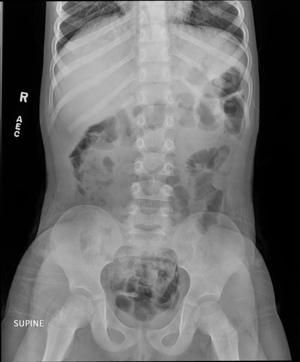Constipation: What's the Diagnosis?
Visual Diagnosis - April 2023
Column Author and Editor: Joe Julian, MD, MPHTM | Hospitalist, Internal Medicine-Pediatrics; Clinical Associate Professor, Internal Medicine & Pediatrics
A 5-year-old female with a pertinent history of constipation presents to the emergency department for abdominal pain. The patient has had generalized abdominal pain for four days and has not had a formed stool in almost seven days. Whenever she attempts to have a bowel movement, the stool is liquid and cannot always be controlled. The family has attempted increasing polyethylene glycol (PEG), using sennosides, and attempted over-the-counter enemas without success. She has no associated fever, but she started having nausea and non-bloody, non-bilious emesis earlier in the day. Her fluid intake has decreased significantly due to emesis, but urine output remains the same. Her mother states that this combination of symptoms is typical of her constipation and how it tends to present. She has had no prior abdominal surgeries.
Vitals signs are within age-appropriate limits. Examination is notable for mild periumbilical tenderness but no rebound or guarding. There are hypoactive bowel sounds. She is non-toxic in appearance. Capillary refill is two seconds.
Abdominal radiography is shown below.

Question #1
What is the next best step in management for this patient?
A. Admission for inpatient bowel cleanout
B. Surgical consultation for disimpaction
C. Administration of enema
D. Administration of oral PEG
Answer #1
C. Administration of enema (correct)
D. Administration of oral PEG (also acceptable)
This patient has worsening of functional constipation with a history that is consistent with prior episodes of constipation and with no red flags (such as fever, bilious emesis or localized pain). While an oral agent could be attempted, her ongoing emesis in the setting of an increased oral regimen at home makes using an enema more practical.
Surgical consultation for disimpaction would not be appropriate. Stool is still being passed and no additional measures have been attempted. Additionally, inpatient admission is not appropriate as no attempts to encourage bowel movements have been made in the emergency department.
Question #2
Which of the following constipation treatments is the least effective?
A. Docusate
B. Sennosides
C. Polyethylene glycol
D. Enemas
Answer #2
A. Docusate
The strongest evidence for constipation treatment is for polyethylene glycol. For disimpaction, enemas and PEG are both equally efficacious. Enemas, in general, are all effective, and selection of type is generally guided by physician preference, institutional formulary and contraindications. Oral docusate has not been shown to be superior to placebo. Docusate enemas are reasonable, but alternative oral agents should be used.
Clinical Course
The patient received a milk of molasses enema resulting a moderate-sized bowel movement. She was able to tolerate oral intake, but admission was requested for persistent abdominal pain. A nasogastric tube was inserted with radiographic confirmation, and the patient was started on PEG + electrolyte solution. Additionally, she was started on sennosides. She had extensive bowel movements, tolerated a regular diet with decreased pain, and was discharged later that day. Her home constipation action plan was modified to create an earlier increase in PEG given her frequent admissions for cleanout.
Things to consider when addressing constipation
Use history and physical to diagnose constipation.
Use the Rome III diagnostic criteria for functional constipation. Radiography generally does not change the diagnosis or management unless the patient has a history of abdominal surgery or has symptoms concerning for obstruction.
Oral polyethylene glycol (PEG) is still the champion.
Oral docusate should be replaced with a more effective agent.
PEG is useful for both maintenance and disimpaction. Docusate has not been shown to be superior to placebo, and more effective medications should be considered.
Hospitalization is not always needed to treat constipation/disimpaction.
Stools do not need to be “clear” unless the patient is undergoing colonoscopy.
Children with prior extensive abdominal surgeries or who have failed full-scale/appropriately dosed outpatient cleanout regimens are patients who could be considered for admission depending upon their clinical course in a non-inpatient setting. Patients who are admitted do not need to receive inpatient treatment until their stools are clear. Generally, improvement in stool output and ability to tolerate an oral regimen are good signs a patient is ready for discharge.
Use constipation action plans to empower patients and families.
Similar to an asthma action plan, giving families the ability to “step up” and “scale down” a bowel regimen can prevent unnecessary use of medical resources and allow families to maintain their normal lives. See below for examples of tools that can be used to create plans for patients:
My Constipation Action Plan (free text/drop down PDF fields to create plans for patients)
Constipation: Cleanout Action Plan (checkboxes to create action plans for patients)
References:
- Allison A, Sweet C, Knopp M. Implementation of a constipation action plan for patients discharged from a pediatric hospitalist service. J Pediatr Pharmacol Therap. 2021;26(7):718-722.
- Harrison W, Kumar A, Quinonez R, Stephens JR. Things we do for no reason: routinely hospitalizing children with fecal impaction for inpatient cleanouts. J Hosp Med. Published online September 8, 2022. doi:10.1002/jhm.12959
- Hoskins B, Marek S. Things we do for no reason: obtaining an abdominal x-ray to assess for constipation in children. J Hosp Med. 2020;15(9):557-559.
- Koppen IJ, Lammers LA, Benninga MA, Tabbers MM. Management of functional constipation in children: therapy in practice. Paediatr Drugs. 2015;17:349-360.
- Tabbers MM, DiLorenzo C, Berger MY, et al. Evaluation and treatment of functional constipation in infants and children: evidence-based recommendations from ESPGHAN and NASPGHAN. J Pediatr Gastroenterol Nutr. 2014:58(2):258-274.
See all the articles in this month's Link Newsletter
Stay up-to-date on the latest developments and innovations in pediatric care - read the April issue of The Link.